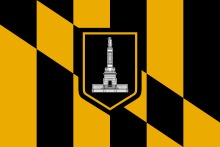Baltimore club
| Baltimore club | |
|---|---|
| Stylistic origins | |
| Cultural origins | Late 1980s; Baltimore, United States |
| Typical instruments | |
| Derivative forms | |
Baltimore club, also called Bmore club, Bmore house or simply Bmore, is a breakbeat genre. A blend of hip hop and chopped, staccato house music, it was created in Baltimore, Maryland, United States in the late 1980s by 2 Live Crew's Luther Campbell, Frank Ski, Miss Tony (known as Big Tony after he ceased presenting in drag), Scottie B. and DJ Spen.[1]
Baltimore club is based on an 8/4 beat structure, and includes tempos around 130 beats per minute.[2][3] It combines repetitive, looped vocal snippets similar to trap, bounce, ghetto house and ghettotech. Baltimore club is a sample based form of breakbeat, with samples used including theme songs to shows like Sanford and Son, SpongeBob SquarePants and Elmo's World,[3] along with samples from shows like Family Guy, South Park & Ren & Stimpy - though can also be simple repeated phrases and chants. The instrumental tracks include heavy breakbeats and call and response stanzas similar to those found in the go-go music of Washington, D.C.. The breakbeats are pulled from samples, with the most prominent being "Sing Sing" by disco band Gaz[4] and "Think (About It)" by Lyn Collins.[5] Much like the rave-era genre known as breakbeat hardcore, Baltimore club sounds as if the music was intentionally hurried, as each song is made with a limited palette of sounds and is based on similar frameworks.
Development
Baltimore club was born in the record stores of Baltimore first by Scottie B, Shawn Caesar and DJ Equalizer. They were then joined by DJ Patrick, Kenny B, DJ Class, Diamond K and others. They took some inspiration for their sets and production from British breakbeat hardcore records.The Blapps! Records (UK) label released several records between 1989 and 1992 that are considered classics in the Baltimore genre, as well as in the British rave scene. "Don't Hold Back", "Too Much Energy" and "Let the Freak" were sampled and played heavily by DJs and producers, and would define the Baltimore club sound.
In the early 1990s, Baltimore club music developed a cult following in the North Jersey club scene, particularly in the Jersey club genre of Newark, New Jersey developed by DJ Tameil. This spread stems from the distribution of mix tapes from traveling Baltimore DJs. There were also a number of Boston-area radio shows in the mid-nineties that played Baltimore club music. It has also spread south to Virginia club scene (VA 757 Club) and even farther south in Alabama with DJ Seven formally known as DJ Taj developed Bamabounce. It has also started to spread to New York City.
Recently the genre has gained popularity in Baltimore's rock underground, due to Baltimore club nights at the Talking Head Club and others. Baltimore club was featured in Spin Magazine in December 2005.[6]
Rod Lee was described as "the original don of Baltimore Club" by The Washington Post in 2005.[7]
Bmore club music adds authentic texture to the soundscape of David Simon's HBO series The Wire. A scene in season two demonstrates the importance of club music in defining space that disadvantaged locals know as their home.[8] The character Bodie becomes confused, thinking that the rented van's radio must be broken, when the station that plays club music fades to static and then A Prairie Home Companion on the road from Baltimore to Philadelphia to pick up a "package" of heroin. In season four, assassins working for a local drug operation identify interlopers from New York by quizzing them about club artists.[9]
Following local uprisings in response to the death of Freddie Gray, Miss Tony, who lived in the same Sandtown-Winchester neighborhood as Gray, has been newly appreciated for his contributions to Baltimore's culture and counterculture. Miss Tony has been an icon to members of Baltimore's queer community,[10] and local rappers continue to riff on the refrain of Miss Tony's "How U Wanna Carry It?" as a challenge to respond to local social needs.[11]
Now, the style and its direct derivatives are becoming exceptionally popular on the internet due to music sharing websites such as soundcloud.com, and is becoming popular across the United States, Australia and Europe.
References
- ↑ Deveraux, Andrew (December 2007). "What You Know About Down the Hill?": Baltimore Club Music, Subgenre Crossover, and the New Subcultural Capital of Race and Space". Journal of Popular Music Studies. 19 (4): 311–341. doi:10.1111/j.1533-1598.2007.00131.x. Retrieved 2008-01-19.
- ↑ Reid, Shaheem; Paco, Matt (2007). "Young Leek & the Baltimore Scene". MTV Networks. Archived from the original on 11 January 2008. Retrieved 2008-01-19.
- 1 2 Bernard, Patrick (2006-07-03). "Scottie B and Baltimore Club". The Wire. Archived from the original on 2008-01-12. Retrieved 2008-01-19.
- ↑ Host, Vivian (September 7, 2014). "Sing Sing: A Loop History". Red Bull Music Academy. Retrieved April 13, 2015.
- ↑ Shipley, Al (2006-01-19). "The Best Of Both Worlds". Baltimore City Paper. Retrieved 2008-01-19.
- ↑ "Dance the Pain Away". Spin. 2005-12-03. Retrieved 2017-06-04.
- ↑ Inoue, Todd (July 31, 2005), "Rod Lee, Putting B-More On the Map", The Washington Post
- ↑ Tuscano, Alberto; Kinkle, Jeff. "Baltimore as World and Representation: Cognitive Mapping and Capitalism in The Wire". Dossier.
- ↑ Caramanica, Jon (2006-09-10). "For 'The Wire,' Rap That's Pure Baltimore". The New York Times. ISSN 0362-4331. Retrieved 2018-01-11.
- ↑ Burney, Lawrence (2016-10-18). "Baltimore's Creative Community Still Looks to Queer Icon Miss Tony for Inspiration". Thump. Retrieved 2018-01-11.
- ↑ Soderberg, Brandon (2016-05-17). "The life of Baltimore icon Miss Tony and the death of Freddie Gray". FACT Magazine: Music News, New Music. Retrieved 2018-01-11.
Further reading
- Inoue, Todd. "Rod Lee, Putting B-More On The Map." The Washington Post. 07/31/2005. N02.
- Janis, Stephen; Lee, Rod; Young, Omar Akbar. "Labtekwon & Rod Lee Interview" (PDF). Link. 9: 56–64.
- Soderberg, Brandon. "61 Digressions About Baltimore Club Music." City Paper. 06/22/2016.

